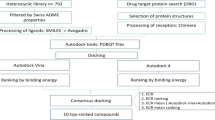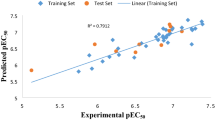Abstract
Pharmacophore hypotheses were developed for molecules having antimalarial activities targeting the haem detoxification pathway of the malaria parasite. A training set consisting of 23 compounds was selected to generate these hypotheses, and their activities were evaluated for haem polymerization inhibition and against chloroquine-sensitive (3D7) as well as chloroquine-resistant (K1) strains of p. falciparum. The models were cross-validated by Fischer’s randomization test at a 95% confidence level. The model developed against chloroquine-resistant malaria parasites was found to yield the best predictions among the three models.




Similar content being viewed by others
References
Auparakkitanon S, Noonpakdee W, Ralph RK, Denney WA, Wilairat P (2003) Antimalarial 9-anilinoacridine compounds directed at hematin. Antimicrob Agent Chemother 47:3708–3712
Ayad F, Tilley L, Deady LW (2001) Synthesis, antimalarial activity and inhibition of haem detoxification of novel bisquinolines. Bioorg Med Chem Lett 11:2075–2077
Bray PG, Hawley SR, Mungthin M, Ward SA (1996) Physicochemical properties correlated with drug resistance and the reversal of drug resistance in plasmodium falciparum. Mol Pharmacol 50:1559–1566
CATALYST 4.10, Accelrys Inc., San Diego, CA (2005) http://www.accelrys.com
Chopra M, Mishra AK (2005) Ligand-based molecular modeling study on a chemically diverse series of cholecystokinin-B/gastrin receptor antagonists: Generation of predictive model. J Chem Inf Model 45:1934–1942
Dorn A, Scovill JP, Ellis WY, Matile H, Ridley RG, Vennerstrom JL (2001) Floxacrine analogue WR 243251 inhibits hematin polymerization. Am J Trop Med Hyg 65:19–20
Dorn A, Stoffel R, Matile H, Bubendorf A, Ridley R (1995) Malarial haemozoin/β-haematin supports haem polymerization in the absence of protein. Nature 374:269–271
Dorn A, Vippagunta SR, Matile H, Jacquet C, Vennerstrom J.L, Ridley RG (1998) An assessment of drug–haematin binding as a mechanism for inhibition of haematin polymerisation by quinoline antimalarials. Biochem Pharmacol 55:727–736
Egan TJ, Marques HM (1999) The role of haem in the activity of chloroquine and related antimalarial drugs. Coord Chem Rev 190–192:493–517
Egan TJ, Mavuso WW, Ross DC, Marques HM (1997) Thermodynamic factors controlling the interaction of quinoline antimalarial drugs with ferriprotoporphyrin IX. J Inorg Biochem 68:137–145
Fidock DA, Nomura T, Talley AK, Cooper RA, Dzekunov SM, Ferdig MT, Ursos LMB, Sidhu ABS, Naude KW, Deitsch KW, Su X, Wootton JC, Roepe PD, Wellems TE (2000) Mutations in the P. falciparum digestive food vacuole transmembrane protein PfCRT and evidence for their role in chloroquine resistance. Mol Cell 6:861–871
Goldberg DE, Slater AFG (1992) The pathway of hemoglobin degradation in malaria parasites. Parasitol Today 8:280–283
Guillon J, Grellier P, Labaied M, Sonnet P, Leger J-M, Deprez-Poulain R, Forfar-Bares I, Dallemagne P, Lemaitre N, Pehoureq F, Rochette J, Sergheraert C, Jarry C (2004) Synthesis, antimalarial activity, and molecular modeling of new pyrrolo[1,2-a]quinoxalines, bispyrrolo[1,2-a]quinoxalines, bispyrido[3,2-e]pyrrolo[1,2-a]pyrazines, and bispyrrolo[1,2-a]thieno[3,2-e]pyrazines. J Med Chem 47:1997–2009
Guner OF (2000) Pharmacophore perception development and use in drug design, International University Line, La Jolla, CA, pp. 173
Hawley SR, Bray PG, Mungthin M, Atkinson JD, O’Neill PM, Ward SA (1998) Relationship between antimalarial drug activity, accumulation, and inhibition of heme polymerization in plasmodium falciparum in vitro. Antimicrob Agent Chemother 42:682–686
Kalkanidis M, Klonis N, Tilley L, Deady LW (2002) Novel phenothiazine antimalarials: Synthesis, antimalarial activity, and inhibition of the formation of β-hematin. Biochem Pharmacol 63:833–842
Kurosawa Y, Dorn A, Kitsuji-Shirane M, Shimada H, Satoh T, Matile H, Hofheinz W, Masciadri R, Kansy M, Ridley RG (2000) Hematin polymerization assay as a high-throughput screen for identification of new antimalarial pharmacophores. Antimicrob Agent Chemother 44:2638–2644
Onyeibor O, Croft SL, Dodson HI, Feiz-Haddad M, Kendrick H, Millington NJ, Parapini S, Phillips RM, Seville S, Shnyder SD, Taramelli D, Wright CW (2005) Synthesis of some cryptolepine analogues, assessment of their antimalarial and cytotoxic activities, and consideration of their antimalarial mode of action. J Med Chem 48:2701–2709
Pagola S, Stephens PW, Bohle DS, Kosar AD, Madsen SK (2000) The structure of malaria pigment β-haematin. Nature 404:307–310
Portela C, Afonso CMM, Pinto MM, Ramos MJ (2003) Receptor–drug association studies in the inhibition of the hematin aggregation process of malaria. FEBS Lett 27435:217–222
Sherman IW (1977) Amino acid metabolism and protein synthesis in malarial parasites. WHO Bull 55:265–276
Stead AMW, Bray PG, Edwards IG, Dekoning HP, Elford BC, Stocks PA, Ward SA (2001) Diamidine compounds: Selective uptake and targeting in Plasmodium falciparum. Mol Pharmacol 59:1298–1306
Wright CW, Addae-Kyereme J, Breen AG, Brown JE, Cox MF, Croft SL, Gokcek Y, Kendrick H, Phillips RM, Pollet PL (2001) Synthesis and evaluation of cryptolepine analogues for their potential as new antimalarial agents. J Med Chem 44:3187–3194
Acknowledgements
We thank Shri K. Sekhar, Director DRDE, Gwalior for his keen interest and encouragement in the present study. We especially thank Dr. Chandan Ray Chaudhary, Accelrys, Bangalore, for his constant support and timely suggestions.
Author information
Authors and Affiliations
Corresponding author
Rights and permissions
About this article
Cite this article
Acharya, B.N., Kaushik, M.P. Pharmacophore-based predictive model generation for potent antimalarials targeting haem detoxification pathway. Med Chem Res 16, 213–229 (2007). https://doi.org/10.1007/s00044-007-9025-8
Received:
Accepted:
Published:
Issue Date:
DOI: https://doi.org/10.1007/s00044-007-9025-8




